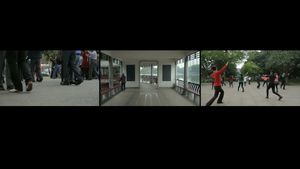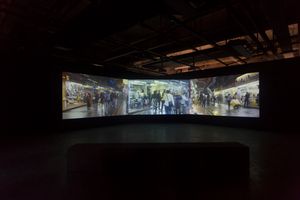GZ Calling
2017
GZ Calling_01_Production Still_2017_(c)Lale/Hopkins-1
Precariat’s Meeting (2017.11.08 Wed - 2018.01.07) - Ming Contemporary Art Museum (mcam)
original publicationWe are not only living in an era that witnesses mass mobilization caused by globalization. From the migration of population driven by production, trade and war to people who are forced to move due to the appearance of deathtrap and backwater, it seems that globalization has never achieved the vision of the word “globe” assumed to be. On the contrary, in today’s context, globalization rapidly transcends the traditional logic of “production – consumption”, and with the support from the financial, arithmetic and legal perspectives, the control over mobility is becoming increasingly precise and inconspicuous. In the meantime, ideological struggles have never recessed; instead, they have permeated every aspect of life in the face of “amiable” contemporary lifestyle.
Art, inevitably, is an integral part of all that. As part of the city’s urban planning, in the past few years art activities from all over the globe have been “diverted” to different specific areas of the city in a highly precise manner. Such “diversion” no longer appears as some kind of violent interference. Rather, under the guidance on the finance and policy levels, such activities in fact become an integral element of the cultural and economic planning under the global context, networking the seemingly connected but actually isolated individuals and institutes. Moreover, as David Harvey pointed out in his Rebel Cities: from the Right to the City to the Urban Revolution,“capital has ways to appropriate and extract surpluses from local differences, local cultural variations, and aesthetic meanings of no matter what origin.” The flexibility of capital is constantly digesting the locality and individuality of artistic practice, making them become more and more stable and controllable.
How can art workers, or in Antonio Negri’s words the “artists as precarious workers” or “precarious workers as artists” make cracks within the fog of invisible control and illusory diversities, criticize, practice and invent autonomous and genuine mobility and connection? As art space and public/labor space that cannot be deprived from social productive relations, what role should art museum play? The above two interconnected questions constitute a point of departure for curating this exhibition. The exhibition will occupy both the internal and external space of the Ming Contemporary Art Museum, invite artists and the public to join, and turn it into a site brimming with a constant sense of presence, and precarious sense of production, conflicts, negotiation and interaction.

GZ Calling_01_Production Still_2017_(c)Lale/Hopkins-1
The first part of the exhibition consists of three mobility-related projects and will occupy the outdoor space of the museum. Guerrilla Living Syndrome!initiated by Ma Yongfeng investigates the social actions and practices of “alternative living practice” and “guerrilla architecture”, and explores for the possibility of a kind of guerrilla-like, flexible and time-based living practice through the unique contribution by each participant. Uncut, a radio project launched by the artist, will be used as a promotion station for the project. Weed Party: Kindred (new commission) by Zheng Bo is a continuation of his “Weed Party” project. By transplanting the weeds around the museum to the elevator inside Shanghai Paper Machinery Factory (former site of the museum), the artist will write and read letters about the weed together with public, juxtaposing the ordinary and obscure plants in the same space with the people on the move. Said to Contain is a long-term and ongoing project collectively initiated by Bojan Djordjev, Laura Kalauz, Maja Leo, Christopher Kriese, Lisa Schröter and Miriam Walther Kohn in 2016, aiming to re-trace the global trading mechanism. Following the investigation and presentation in Hamburg and Buenos Aires, Said to Contain will conduct a two-month field research in Shanghai and present workshops, rehearsals and performance during the process.
The second part of the exhibition consists of the projects by Abraham Cruzvillegas, Haig Aivazian, Zhao Zhao, Marta Popivoda and Shi Qing. Abraham Cruzvillegas’The Water Trilogy 1: Ichárhuta: Autodefensión Approximante Vibrante Retroflexe pays attention to the significant decrease of the water level of Lake Pátzcuaro, one of the three major lakes in Mexico, as well as the that are on the verge of disappearance. Haig Aivazian’s film How Great You Are O Son of Desert!, links the figure of football star Zinedine Zidane to the collective figure of “inner city” youth from the France’s Sensitive Urban Zones (Z.U.S) by combining press archives, with drawings and infographics created by the artist. His Installation 1440 Sunsets per 24 Hours treats the lighting system as a double-edged sword to expose, highlight or conceal the subject, and probes into how it works to control the brightness of public space as well as the stadiums. Also, the artist will present an audio visual lecture entitled AntiWorld: On Seeing Double on site, which starts from the three explosions near France’s national sports stadium, the Stade de France, move onto the past and future of surveillance technology, and discuss about how we are constructed and de-constructed either collectively or individually by the intersecting gazes of law, capital and machines.

GZ Calling_01_Production Still_2017_(c)Lale/Hopkins-2
Zhao Zhao’s Taklamakan Project, on the other hand, intends to probe into the issue of locality and social identity in a broader sense with a personal touch. A work Camel, inspired by his recent exhibition Desert, Camel will also be on view at the exhibition. Marta Popivoda’s project Mass Ornament #1-3 endeavors to ponder upon the relationship between ideologies, grand narration, democratic politics and individuals through a revisit from the national/mass activities of the former Yugoslavian countries to the protests, demonstrations, celebrations and other large-scale social and cultural activities all over the world nowadays. During the opening period, Popivoda’s film Yugoslavia, How Ideology Moved Our Collective Body will be premiered at the museum. Shi Qing’s Lu Xun Zoo (new commission) develops around the last ten years of Lu Xun in Shanghai. Borrowing the intricate relation between the left-wing literature and Lu Xun in the 1930s in Shanghai as a metaphor, the work intends to offer an alternative way to interpret, and to overturn, fold and integrate desires, radical politics and contemporary art landscape.
The third part of the exhibition starts from Social Sensibility R&D Department, connecting Li Xiaofei’s Assembly Line Project, Payne Zhu’s 赖克/LIKE, Sam Hopkins’GZ Calling and Paper Tiger Studio’s 500 Meter. Social Sensibility R&D Department is an art department affiliated to Bernard Controls, a multinational industrial company. Founded by Alessandro Rolandi in 2012, the department is run by artists Zhao Tianji and Blandine De la Taille in Beijing and Paris respectively. The program will invite artists to stay at the factory as resident participant and work in collaboration with the workers. In producing artworks, the artists-workers intervened with the everyday relations of production of the factory on a deep level. Social Sensibility R&D will continue their production during the period of the exhibition inside the Ming Contemporary Art Museum, and foster interaction between Beijing, Shanghai and Paris. Assembly Line Project is an ongoing project initiated by Li Xiaofei in 2010. The artist has continuously taken pictures of more than 100 factories of all types and all over the world. The presentation of the photographs of the Assembly Line Project intends to investigate the assembly line that is beyond order and hence invisible – in other words, the standardization of capital factory, consumer society, social progress and values as well as the reality that human beings are faced with when they are situated in a highly systematic and institutionalized environment. Payne Zhu’s 赖克/LIKE manages to create a new brand by using a symbol very much alike Nike’s logo, which even gives rise to a series of advertisements and products. He endeavors to probe into issues behind so-called brand, such as identity, colonization, poverty, consumption and dream-making marketing strategy, through LIKE Football, LIKE Marathon, Competition of Spokesperson and LIKE Investment(new commission).

GZ Calling_01_Production Still_2017_(c)Lale/Hopkins-3
Sam Hopkins and David Lalé’s GZ Calling casts light on the life of the Africans who have immigrated to Guangzhou, a strategic gateway of the South-South Trade, due to the influence of globalization. From an outsider’s perspective, GZ Calling leads audience to take a look at the African community in Guangzhou:“a world within world” that is mysterious and somewhat resistant to the outside world, as well as some unique customs formed by these diasporas.500 Meters-Kafka, Great Wall, Image from the Unreal World and Daily Heroism is a theatre performance co-produced by director Tian Gebing and dramaturgist Christoph Lepschy. Based on Kafka’s novel of The Great Wall of China, the play intends to explore the intricacies among individual, state will and collective construction. The performance was previously premiered at the Hamburg Theater der Welt 2017 and Ming Contemporary Art Museum respectively. As a continuation of the project, a space named 500 Meters- The Further Back They Are in Time, The More Terrible All Their Colours Glow(new commission) that will gradually be destructed during the exhibition will be constructed for the exhibition.
In the meantime, the exhibition intends to reflect upon the function of both the exhibition itself as well as the venue where it takes place, the art museum. Through Fong Fo’s Fong Fo Forever Advertisements (new commission), the curator and the artists review and reevaluate the dubious promotional information, images and institutionalized exhibition design developed from exhibition-related texts. During the exhibition, the museum will turn into a lieu for daily activities. On the opening day, Bojan Djordjev’s theatre performance The Discreet Charm of Marxism will invite audience to join a six-course dinner party consisting of contemporary Marxist theories. When the performance comes to an end, the theatre will be transformed into a self-service canteen. Circus: Thought Struggle 2017.11(new commission), a long-term project initiated by Zhao Chuan and Chen Jianhe, manages to place personal space into the public space of the exhibition. The artists will live and work here during the exhibition period, probing into the multilayer activities of “thought” and its performative nature, and searching for the energy for individuals to resist/overturn within public space.
To connect what is beyond connection, art museum = market, sports stadium, theatre, square and battlefield

GZ Calling_01_Production Still_2018_(c)MCAM
download text as PDF